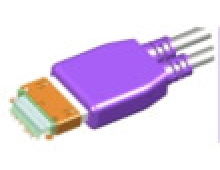
PCI Special Interest Group Discusses PCIe 4, 32 Gbps Interconnction Cable
At its annual meeting and developer conference in California, the PCI Special Interest Group announced plans to create a cabled version of PCI Express 3 that will take on the Thunderbolt interconnect, and also setimated that the PCI Express 4, which will deliver at least 16 GTransfers/second will debut in products in about four years.
The group believes that it is able to squeeze out of copper links at least one more high speed version of PCI Express before a likely transition to optical interconnects. PCIe Gen 4 is expected to deliver at least 16 GTransfers/second when it debuts in products in four years.
EEtimes reported that AMD, HP, IBM and Intel are currently conducting simulations using chip, channel, packet and socket data. They have determined throughput of at least 16 GT/s is possible and are expected to deliver a final report before the end of the year.
PCIe Gen 4 will probably be limited to distances of about eight to 12 inches compared to 20 inches for Gen 3. However, longer reaches could be achieved by using repeaters.
Currently, the PCI SIG has been promoting the 8 GT/s PCIe Gen 3 specifications. Engineers are making process getting 8 GT/s PCIe 3.0 products out the door. At least 14 companies with building block cores, software or testers have announced Gen 3 support.
The PCI SIG hopes to publish by early next year a list of products that have passed PCIe Gen 3 interop tests.
The PCI SIG also discussed the development of a cabled version of PCI Express that will take on the Thunderbolt interconnect as well as USB 3.0. The PCIe approach will be more open and more optimal than Thunderbolt for delivering high throughput I/O to tablets and thin notebooks.
The new cable will be based on PCIe 3.0 which supports up to 8 GTransfers/second. It likely will support a maximum of four parallel lanes for throughput up to 32 Gbits/s and distances no longer than three meters.
While initially focused on copper, the technology is expected to migrate to higher speed copper and optical links. The road map likely leads to a 16 GT/s version based on PCIe Gen 4 in about four years as well as an optical version for longer reach and/or higher data rates at some point.
The PCIe cable also will support power to peripherals at levels likely less than 20W.
The new spec is aimed at consumer uses for desktop and mobile PCs and tablets as well as their peripherals such as external storage devices.
Details of the new standard will be defined by a working group now being formed. The group is expected to deliver a standard system makers can implement in products before June 2013.
Other than Apple and Intel, only Sony has so far been reported to have plans to support Thunderbolt. The PCI SIG's decision to create a competing technology suggests mainstream PC makers on the PCI SIG board such as Dell and Hewlett-Packard do not want to adopt Thunderbolt.
EEtimes reported that AMD, HP, IBM and Intel are currently conducting simulations using chip, channel, packet and socket data. They have determined throughput of at least 16 GT/s is possible and are expected to deliver a final report before the end of the year.
PCIe Gen 4 will probably be limited to distances of about eight to 12 inches compared to 20 inches for Gen 3. However, longer reaches could be achieved by using repeaters.
Currently, the PCI SIG has been promoting the 8 GT/s PCIe Gen 3 specifications. Engineers are making process getting 8 GT/s PCIe 3.0 products out the door. At least 14 companies with building block cores, software or testers have announced Gen 3 support.
The PCI SIG hopes to publish by early next year a list of products that have passed PCIe Gen 3 interop tests.
The PCI SIG also discussed the development of a cabled version of PCI Express that will take on the Thunderbolt interconnect as well as USB 3.0. The PCIe approach will be more open and more optimal than Thunderbolt for delivering high throughput I/O to tablets and thin notebooks.
The new cable will be based on PCIe 3.0 which supports up to 8 GTransfers/second. It likely will support a maximum of four parallel lanes for throughput up to 32 Gbits/s and distances no longer than three meters.
While initially focused on copper, the technology is expected to migrate to higher speed copper and optical links. The road map likely leads to a 16 GT/s version based on PCIe Gen 4 in about four years as well as an optical version for longer reach and/or higher data rates at some point.
The PCIe cable also will support power to peripherals at levels likely less than 20W.
The new spec is aimed at consumer uses for desktop and mobile PCs and tablets as well as their peripherals such as external storage devices.
Details of the new standard will be defined by a working group now being formed. The group is expected to deliver a standard system makers can implement in products before June 2013.
Other than Apple and Intel, only Sony has so far been reported to have plans to support Thunderbolt. The PCI SIG's decision to create a competing technology suggests mainstream PC makers on the PCI SIG board such as Dell and Hewlett-Packard do not want to adopt Thunderbolt.














